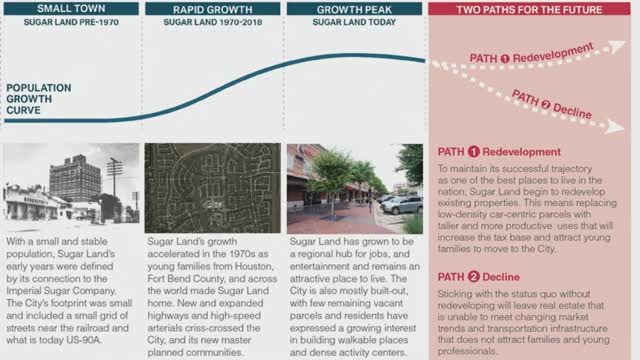City faces housing crisis as growth stalls
August 14, 2024 | Sugar Land, Fort Bend County, Texas
This article was created by AI summarizing key points discussed. AI makes mistakes, so for full details and context, please refer to the video of the full meeting. Please report any errors so we can fix them. Report an error »

In a recent government meeting, officials discussed the evolving life cycle of Sugar Land, highlighting the city's transition from a small town to a rapidly growing community and the challenges it now faces. The conversation centered on the city's economic development impact cycle, which began with the establishment of Imperial Sugar, leading to job creation and subsequent housing demand. Over the past five years, Sugar Land has seen a 14% increase in jobs, yet only a 2% rise in population, indicating a significant imbalance between employment opportunities and housing availability.
Currently, only 4% of the city's land remains undeveloped, a sharp decline from 15% over the past 15 years. This scarcity of land for new housing has contributed to a population decrease, with recent census data showing a drop from 111,000 to approximately 108,000 residents. Officials noted that this decline is likely due to fewer people per household rather than an increase in vacant homes.
The meeting also addressed the implications of an aging population on city services. As families that moved to Sugar Land in the 1990s remain, the demographic shift has resulted in decreased utilization of elementary schools and youth sports leagues. Additionally, spending per household has declined, reflecting the changing needs of an older population. With 90% of homes designed for families, yet only 34% currently housing children, the city faces critical decisions regarding its future development and community engagement strategies.
Currently, only 4% of the city's land remains undeveloped, a sharp decline from 15% over the past 15 years. This scarcity of land for new housing has contributed to a population decrease, with recent census data showing a drop from 111,000 to approximately 108,000 residents. Officials noted that this decline is likely due to fewer people per household rather than an increase in vacant homes.
The meeting also addressed the implications of an aging population on city services. As families that moved to Sugar Land in the 1990s remain, the demographic shift has resulted in decreased utilization of elementary schools and youth sports leagues. Additionally, spending per household has declined, reflecting the changing needs of an older population. With 90% of homes designed for families, yet only 34% currently housing children, the city faces critical decisions regarding its future development and community engagement strategies.
View full meeting
This article is based on a recent meeting—watch the full video and explore the complete transcript for deeper insights into the discussion.
View full meeting
